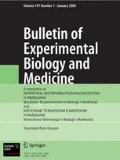We studied the effect of biologically active substances derived from hydrobionts, namely maristim (natural product from sea urchin roe) and fucolam (polysaccharides of fucoidan and calcium alginate from brown algae) on blood biochemistry in the mouse model of nutritional hypercholesterolemia. Maristim and fucolam are found to be capable to normalize the levels of the major indicators of lipid and carbohydrate metabolism and aminotransferase enzyme activity in terms of atherogenic load. Correction action of biologically active substances is more expressed in combined application. Identified experimentally normalizing effects of maristim and on lipid and carbohydrate metabolism allow us to recommend the further study in clinical trials of these biologically active substances and based on them additives.
Similar content being viewed by others
References
T. V. Alekseyenko, S. Ya. Zhanayeva, A. A. Venediktova, et al., Bull Exp. Biol. Med., 143, No. 6, 730-732 (2007).
D. M. Aronov and V.P. Lupanov, Atherosclerosis and Coronary Heart Disease [in Russian], Moscow (2009).
T. S. Zaporozhets, T. A. Kuznetsova, T. P. Smolina, et al., Zh. Mikrobiol. Epidemiol. Immunobiol., Suppl. No. 3, 54-58 (2006).
D. A. Zateishchikov and P. A. Talyzin, Farmateka, No. 13, 1-10 (2006).
T. A. Kuznetsova, I. G. Agafonova, T. S. Krokhmal’, et al., Tikhookeansk. Med. Zh., No. 4, 32-35 (2010).
K. V. Maistrovskii, T. S. Zaporozhets, L. N. Fedyanina, et al., Tikhookeansk. Med. Zh., No. 3, 103-105 (2009).
I. D. Makarenkova, G. N. Leonova, O. S. Maistrovskaya, et al., Tikhookeansk. Med. Zh., No. 1, 44-46 (2012).
S. Yu. Martsevich, Rats. Farmakoter. Kardiol., No. 4, 76-79 (2009).
K. J. Kim, O. H. Lee, and B. Y. Lee, Life Sci., 22, No. 21-22, 791-797 (2010).
D. Y. Li, Z. Xu, L. M. Huang, et al., Food Sci., 22, No. 2, 92-95 (2001).
S. E. Nissen, S. J. Nicholls, I. Sipahi, et al., JAMA, 295, No. 13, 1556-1565 (2006).
M. K. Park, U. Jung, and C. Roh, Mar. Drugs, 9, No. 8, 1359-1367 (2011).
Author information
Authors and Affiliations
Corresponding author
Additional information
Translated from Byulleten’ Eksperimental’noi Biologii i Meditsiny, Vol. 158, No. 8, pp. 149-152, August, 2014
Rights and permissions
About this article
Cite this article
Kuznetsova, T.A., Kryzhanovskii, S.P., Bogdanovich, L.N. et al. Effect of Biologically Active Substances Derived from Hydrobionts of the Pacific Ocean on Parameters of Lipid Metabolism during Experimental Hypercholesterolemia. Bull Exp Biol Med 158, 188–191 (2014). https://doi.org/10.1007/s10517-014-2719-2
Received:
Published:
Issue Date:
DOI: https://doi.org/10.1007/s10517-014-2719-2



